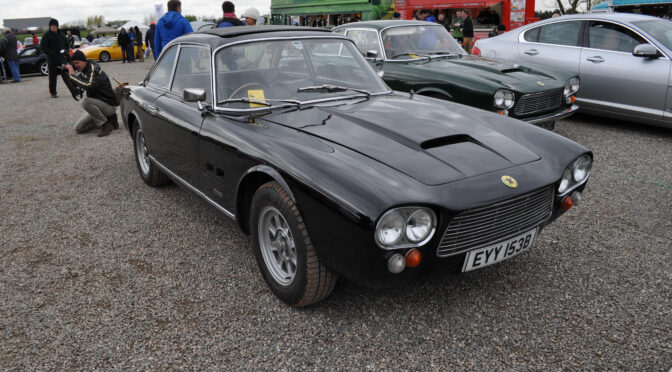A-Z of Car Stuff
This is one in a series of posts on cars, drivers, designers etc. that have interested me over the years. I’ve bored my family and friends with this stuff for years – now it’s your turn!
See A-Z of Car Stuff page for more posts in this series.
So, what’s so special about Gordon Keeble?
1) The name! Let’s face it – if someone asks you what you’re driving these days and you respond by saying with “well actually old chap I’m driving a Gordon Keeble” it’s highly likely to be a conversation stopper. You might as well say – “I’m driving a Milton Keynes”.
2) Beautiful and understated Italian designed GT bodywork. This was a Giorgietto Guigaro design when he was still working for Bertone and it contains some design details which link it to other Guigaro designs for Alfa Romeo in particular. Unusually – the bodywork was executed in fibreglass instead of metal but this doesn’t detract from the overall beauty of the car.
3) Seriously powerful and flexible Chevy Corvette engine, all round disk brakes and De Dion suspension. Depite being manufactured in tiny numbers – there were some great design features on this car and using a race proven engine, Dunlop disk brakes and sophisticated De Dion rear suspension was a master stroke.
4) Its rarity but also it’s influence on cars to follow. Only 100 Gordon Keebles were made of which around 90 are thought to survive. Despite this – certain aspects of Gordon Keeble design had a profound influence on Giotto Bizzarrini in his creation of the Iso Rivolta GT, the Iso Grifo and the Bizzarrini 5300 GT Strada/Corsa.
5) Its tortoise badge. This was a more than ironic touch as the car’s power train meant it was definitely no slouch with 70mph achievable in 1st gear and with a 140mph top speed.
Origins

The fact that the Gordon Keeble came into existence (albeit in tiny numbers) was testament to the perseverance and downright bravery of two inspired and talented people. The name is derived from its two designers – John Gordon & Jim Keeble who drew upon their respective knowledge of chassis design and racing to create the car. John Gordon had previously been involved in Peerless – a company which manufactured a fibre-glass GT car with a square tube spaceframe chassis and Triumph TR3 engine, gearbox and De Dion rear suspension. For such a small company – Peerless earned respect through their involvement in racing and one of their cars even managed 16th place at Le Mans in 1958. Jim Keeble was an experienced racing driver and engineer used to working with American engines. In coming together – the two of them initially built up the Gordon GT using many design features from the Peerless and a proven American engine (Chevrolet Corvette V8). This was developed into the fibre-glass bodied Gordon Keeble. To ensure that their new car was going to make a strong style statement – they enroled the services of a relatively unknown 21 year old Italian designer to design the bodywork – Giorgetto Guigaro who was at that time employed by Bertone the Turin based coach builder.
Italian Job
A rolling chassis of the Gordon GT was built up using a square tube space frame chassis, all round disk brakes and independent suspension and this was dispatched to Bertone in Turin for bodywork to be designed and fitted. The final car from chassis design to fully built up working prototype was completed in just 4 months which is an incredibly short gestation period for a car of this calibre and quality.

There’s an interesting little digression relating to Bertone’s work on the Gordon GT. Nuccio Bertone had links with Renzo Rivolta and to Giotto Bizzarrini. When Rivolta decided he wanted to build a GT car to add high-end car manufacturing to his company’s existing motorcycle and small car (Isetta Bubble car) portfolio – Bertone suggested he assess the Gordon GT. Bizzarrini was tasked with carrying out the assessment and he concluded that the chassis was too flexible to be used on the Iso project but the engine and De Dion suspension were key design elements that should and would be incorporated into the the Iso Rivolta GT. Bizzarrini subsequently worked closely with Nuccio Bertone to create the fantastic Iso Grifo which used a shortened GT chassis and the same drive train.
Rest of the GK Story
The Gordon GT prototype attracted strong interest on the Bertone stand at the 1960 Geneva motor show and it also received support from Chevrolet when it was shown to them in Detroit (ensuring a supply of engines).

Manufacturing of the production model then began in earnest but with some significant changes from the prototype. The steel bodywork was swapped for a fibre glass body shell produced by Williams and Pritchard. John Gordon had previously used fibre glass bodywork on his Peerless cars. The engine was also changed from the 4.6 Litre unit in the prototype to a 5.4 Litre 300 bhp unit offering proving a 140mph top speed and 70mph in 1st gear.

Unfortunately the manufacturing run of Gordon Keeble cars extended to only 90 cars when the company ran into financial difficulties. A further 10 cars were built after a change of ownership resulting in a total number of 100 cars built built between 1964 and 1967 of which around 90 are still believed to exist. So the Gordon GT aka Gordon Keeble aka Keeble Cars represent a rare and interesting marque with their mix of British and American engineering design, Italian bodywork, sophisticated braking/suspension and proven US muscle car power. It’s good to know that such a large proportion of the production run survive to this day and it’s great to see proud owners turning up in numbers at events such as the Donington Historic Festival.

Looking at a Gordon Keeble from various angles you can see some of the same styling features used by Guigarro and Bertone in the Alfa 2600 GT and the Alfa GTV cars of the ’70s but the larger size of the Gordon Keeble seems to soften their styling elements into a more cohesive, elegant and handsome package. The twin headlight frontal aspect of the car shares the slanted “Chinese Eye” style headlights also used by Rolls Royce, Lagonda, Lancia and other manufacturers of the day and this adds to air of class that the car exudes.

The interior of the car looks opulent without being over the top or brash and the whole package makes you feel that you could hop-in at a moments notice, point it towards the continent and blast off to Nice or Biarritz in absolute confidence of arriving in super-quick time and in comfort to arrive just in time for early evening cocktails.
So What About The Tortoise Badge?
There was an initial assumption that through John Gordon’s involvement the car would adopt the Stag’s head emblem of the Clan Gordon of Scotland. When Gordon left the company however – the badge design of the new car was up for grabs. The story goes that in 1963 – active marketing of the car demanded a decision on a noticeable and different bonnet badge. A photographer was assigned to take flattering shots of the car and Tim Parker who accompanied the photographer spotted a tortoise wandering nearby. Jokingly – he picked up the tortoise and placed it on the front of the bonnet claiming “the slowest animal sitting on the world’s fastest four seater”! The idea stuck and the tortoise emblem was adopted as the bonnet badge and emblem of the Gordon Keeble.
Gordon Keeble – Success or Glorious Failure?

One could argue that with such limited production numbers – the car was a failure but I don’t think this is the case. The high survival rate suggests an avid following by GK enthusiasts who really value the rarity, style and performance of the car. Then there’s the link to Giotto Bizzarini – the brilliant Italian designer/engineer who tested the Gordon GT prototype as a possible basis for the Iso Rivolta GT. So impressed was he with the engine and De-Dion rear suspension that these formed key components not only in the Iso Rivolta but also in the Iso Grifo and in his Bizzarrini 5300 GT Strada and Corsa creations. This proves the highly influential design credentials of the Gordon Keeble.
